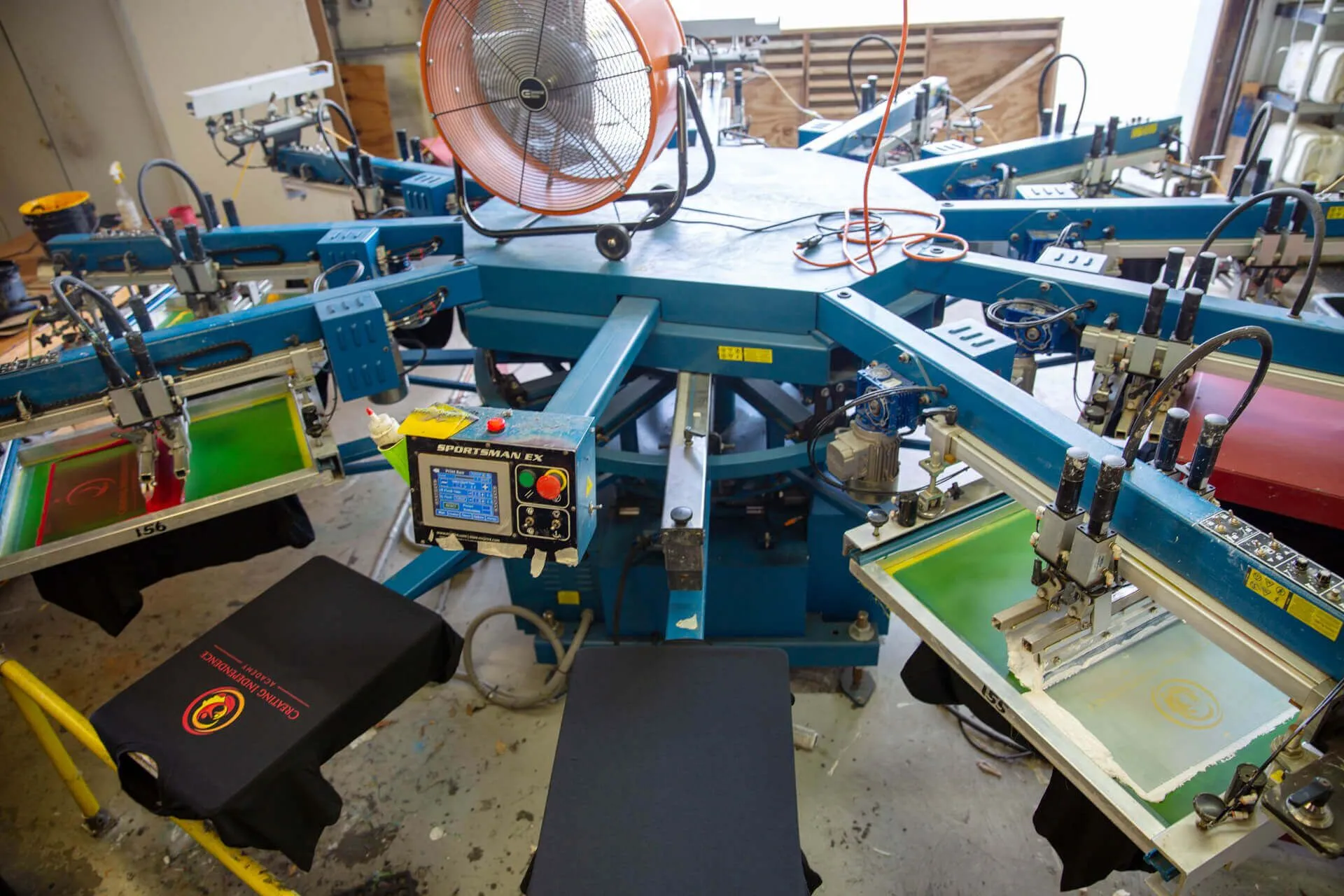Artistic Silk Screen Printing for Limited Edition Prints
Artistic Silk Screen Printing for Limited Edition Prints
Blog Article
Screen Printing Uncovered: Whatever You Required to Know Concerning Tee Shirt and Garment Printing Strategies
Screen printing is a remarkable method that incorporates art with technique, using unlimited possibilities for creativity. All set to explore the vital elements that make screen printing an art type?
The Basics of Screen Printing: How It Functions
When you dive into screen printing, you'll find it's both an art and a science. At its core, screen printing includes producing a pattern, or screen, that allows ink to travel through only in certain areas (screen printing kit). You begin by choosing your design and preparing your display with a light-sensitive solution. As soon as you reveal this emulsion to light, it solidifies, leaving your design as a negative room.
Placement the display over the material, then utilize a squeegee to push ink with the screen onto the garment. Each action is vital, and understanding them will boost your display printing abilities, transforming basic garments right into distinct, meaningful items.
Kinds of Display Printing Techniques
Once you grasp the essentials of display printing, it's time to discover the various techniques that can raise your layouts. One popular technique is traditional screen printing, where ink is pressed through a stenciled display. This technique is fantastic for bold, lively colors. After that there's water-based ink printing, which uses a softer feeling and is eco-friendly, however it calls for a different method to healing.
If you're going for fine information, think about discharge printing. This strategy removes color from the material, leaving a soft, vintage appearance. An additional alternative is plastisol printing, known for its toughness and vivid shades, making it a favored for lots of brand names. Ultimately, try out halftone printing to develop gradient impacts and elaborate designs. Each method has its one-of-a-kind charm, so do not be reluctant to try them out to discover what fits your design best!
Essential Devices for Display Printing
To attain spectacular results in display printing, having the best equipment is essential. You'll require a strong screen printing structure, which holds the mesh that moves your layout onto the garment. Next, spend in premium squeegees; these are vital for using ink uniformly across the screen.
Picking the Right Inks and Materials
When choosing inks and materials for screen printing, you require to take into consideration the kind of ink that works finest for your job. Assume about fabric compatibility to ensure your layouts look last and terrific lengthy. Also, explore environmentally friendly ink options to make your printing procedure a lot more lasting.
Sorts Of Screen Inks
Selecting the appropriate display ink is essential for attaining vibrant, resilient prints that satisfy your project's demands. There are a number of kinds of display inks to examine. Plastisol ink is preferred for its adaptability and ease of use, supplying outstanding color opacity on dark textiles. Water-based ink, on the various other hand, provides a softer feeling and is environment-friendly, making it optimal for those seeking to decrease their environmental influence. Release inks get rid of dye from the textile, causing a soft, classic appearance but need details handling. Specialized inks, such as metal or glow-in-the-dark, can add unique results to your designs. Review your project requirements and choose the ink that lines up best with your wanted outcome.

Textile Compatibility Considerations
Comprehending material compatibility is vital for accomplishing top notch display prints, especially because various materials respond distinctly to numerous inks. Always test your inks on sample material to assure they stick correctly and keep color integrity. Furthermore, maintain in mind that textile weight and appearance can affect the final outcome, so picking the best ink and product combo is essential for your job's success.
Eco-Friendly Ink Options
Green inks are coming to be a preferred option for screen printers that wish to reduce their ecological impact while preserving high quality. When selecting inks, consider water-based inks, which are much less harmful and much easier to tidy up compared to standard solvents. These inks bond well with materials, delivering vibrant results without harmful chemicals. You could likewise explore eco-solvent inks that make use of less unpredictable organic substances (VOCs), making them a more secure alternative for both your health and the planet. i thought about this
In addition, search for inks made from sustainable resources, such as soy or vegetable-based alternatives. By choosing the ideal inks and products, you'll not just develop magnificent styles but likewise add to a more lasting printing procedure. Make the switch, and your prints will mirror your dedication to the atmosphere!
Preparing Your Style for Display Printing

Submit Format Demands
To guarantee your design looks dynamic and sharp on fabric, you'll need to pay close interest to my link file style requirements for screen printing. Make certain your design has a clear history to protect against undesirable white edges on your prints. Maintain color settings in mind; CMYK is conventional for display printing, so transform your RGB designs accordingly.
Shade Separation Methods
Shade splitting up is a crucial action in preparing your style for display printing, and understanding it can substantially boost your print quality. You'll require to break your layout right into individual colors, as each color needs a different display throughout printing. Beginning by determining all the colors in your style and produce layers each. You can utilize software like Adobe Photoshop or Illustrator to separate and separate shades successfully. Be specific to save each layer as a different documents, generally in a layout like TIFF or PSD. This accuracy not just ensures precise color representation however likewise simplifies the printing process. By taking note of color separation, you'll achieve professional and vivid cause your screen-printed garments.
Resolution and Size
Accomplishing the best outcomes in display printing starts with ensuring your design has the right resolution and size. Ideally, your art work must go to least 300 DPI (dots per inch) for sharp, clear prints. If you utilize lower resolution, your end product may look less than professional and pixelated.
When it involves dimension, take into consideration the measurements of your print location. Style your artwork to match the final print dimension, preferably creating it in the real dimensions you'll be printing. This way, you'll avoid any kind of unanticipated scaling concerns.
Always inspect your style in both vector and raster formats. Vector graphics can be scaled without shedding high quality, making them excellent for display printing. Preparing properly will guarantee your layout looks remarkable on every garment!
Step-by-Step Display Printing Refine
Display printing is a dynamic process that enables you to create lively designs on numerous surface areas. To obtain begun, you'll need a display, emulsion, and your chosen ink.
Put ink onto the display and visit the website utilize a squeegee to press the ink with the stencil onto the fabric. Raise the display thoroughly and let the print completely dry. You've effectively screen printed your design.
Tips for Effective Screen Printing Projects
While you're diving into your display printing tasks, bear in mind that preparation is vital to success. Beginning by gathering all your materials-- inks, garments, squeegees, and screens. A tidy office assists prevent unwanted errors, so clean up before you begin.
Following, verify your artwork is high-resolution and effectively sized for your garment. Check your screen for correct direct exposure and tidy it thoroughly to prevent spots. When mixing your inks, comply with the manufacturer's guidelines to achieve the best consistency.
During printing, apply also stress with your squeegee for consistent results. Do not hurry; take your time to validate each print fulfills your requirements. After printing, let your garments completely dry completely before managing or packaging them.
Lastly, constantly maintain a sample of your help future recommendation. By doing this, you can evaluate your progress and boost your strategies with time. Pleased printing!

Frequently Asked Questions
The length of time Does It Require To Establish up a Display Printing Job?
Establishing up a screen printing job commonly takes around half an hour to an hour. You'll prepare the displays, mix inks, and adjust the press. The moment varies based upon intricacy and experience, so remain arranged!
Can I Publish on Various Textile Keys In Utilizing the Same Strategy?
Yes, you can print on various material kinds making use of the very same technique, however you'll require to adjust your inks and setups. Some fabrics take in ink in different ways, so experimenting guarantees the most effective results for each and every product.
What Prevail Blunders to Prevent in Display Printing?
When screen printing, avoid usual blunders like making use of the wrong ink, overlooking appropriate direct exposure times, or avoiding pre-press checks. Constantly examine your setup and preserve tidy displays to assure high quality outcomes each time.
How Can I Effectively Clean and Keep My Screen Printing Equipment?
To properly clean and maintain your screen printing devices, you should regularly wash displays with ideal solvents, check squeegees for wear, and ensure all devices are kept completely dry and dust-free. Uniformity avoids pricey repairs and enhances performance.
Is Screen Printing Eco-friendly Compared to Other Techniques?
Screen printing can be a lot more eco pleasant than various other techniques, specifically if you make use of water-based inks and eco-conscious materials. By choosing sustainable supplies and techniques, you reduce waste and minimize your influence on the planet.
Screen Printing Uncovered: Every Little Thing You Required to Know Concerning T-Shirt and Garment Printing Techniques
At its core, display printing entails developing a stencil, or display, that permits ink to pass through only in specific locations. Setting the screen over the textile, then make use of a squeegee to push ink with the display onto the garment. One prominent approach is standard display printing, where ink is pushed via a stenciled screen.When picking inks and products for display printing, you need to take into account the type of ink that works best for your task.
Report this page